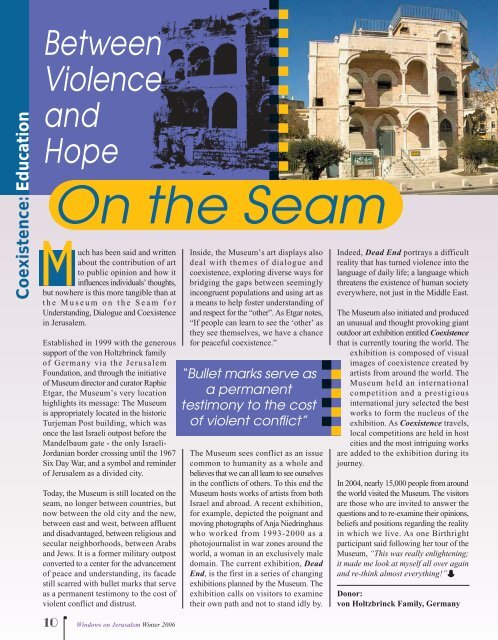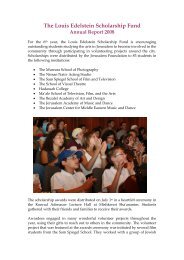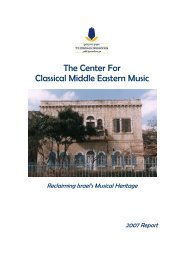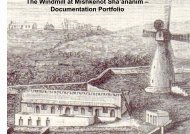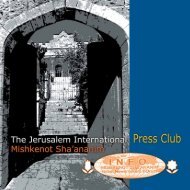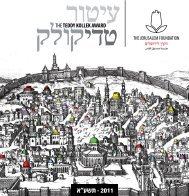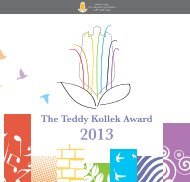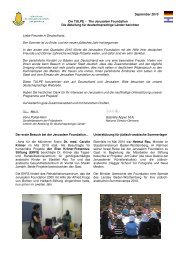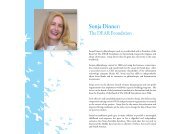Windows Winter 2006 - Jerusalem Foundation
Windows Winter 2006 - Jerusalem Foundation
Windows Winter 2006 - Jerusalem Foundation
You also want an ePaper? Increase the reach of your titles
YUMPU automatically turns print PDFs into web optimized ePapers that Google loves.
Coexistence: Education<br />
Between<br />
Violence<br />
and<br />
Hope<br />
On the Seam<br />
Much has been said and written<br />
about the contribution of art<br />
to public opinion and how it<br />
influences individuals’ thoughts,<br />
but nowhere is this more tangible than at<br />
the Museum on the Seam for<br />
Understanding, Dialogue and Coexistence<br />
in <strong>Jerusalem</strong>.<br />
Established in 1999 with the generous<br />
support of the von Holtzbrinck family<br />
of Germany via the <strong>Jerusalem</strong><br />
<strong>Foundation</strong>, and through the initiative<br />
of Museum director and curator Raphie<br />
Etgar, the Museum’s very location<br />
highlights its message: The Museum<br />
is appropriately located in the historic<br />
Turjeman Post building, which was<br />
once the last Israeli outpost before the<br />
Mandelbaum gate - the only Israeli-<br />
Jordanian border crossing until the 1967<br />
Six Day War, and a symbol and reminder<br />
of <strong>Jerusalem</strong> as a divided city.<br />
Today, the Museum is still located on the<br />
seam, no longer between countries, but<br />
now between the old city and the new,<br />
between east and west, between affluent<br />
and disadvantaged, between religious and<br />
secular neighborhoods, between Arabs<br />
and Jews. It is a former military outpost<br />
converted to a center for the advancement<br />
of peace and understanding, its facade<br />
still scarred with bullet marks that serve<br />
as a permanent testimony to the cost of<br />
violent conflict and distrust.<br />
Inside, the Museum’s art displays also<br />
deal with themes of dialogue and<br />
coexistence, exploring diverse ways for<br />
bridging the gaps between seemingly<br />
incongruent populations and using art as<br />
a means to help foster understanding of<br />
and respect for the “other”. As Etgar notes,<br />
“If people can learn to see the ‘other’ as<br />
they see themselves, we have a chance<br />
for peaceful coexistence.”<br />
“Bullet marks serve as<br />
a permanent<br />
testimony to the cost<br />
of violent conflict”<br />
The Museum sees conflict as an issue<br />
common to humanity as a whole and<br />
believes that we can all learn to see ourselves<br />
in the conflicts of others. To this end the<br />
Museum hosts works of artists from both<br />
Israel and abroad. A recent exhibition,<br />
for example, depicted the poignant and<br />
moving photographs of Anja Niedringhaus<br />
who worked from 1993-2000 as a<br />
photojournalist in war zones around the<br />
world, a woman in an exclusively male<br />
domain. The current exhibition, Dead<br />
End, is the first in a series of changing<br />
exhibitions planned by the Museum. The<br />
exhibition calls on visitors to examine<br />
their own path and not to stand idly by.<br />
Indeed, Dead End portrays a difficult<br />
reality that has turned violence into the<br />
language of daily life; a language which<br />
threatens the existence of human society<br />
everywhere, not just in the Middle East.<br />
The Museum also initiated and produced<br />
an unusual and thought provoking giant<br />
outdoor art exhibition entitled Coexistence<br />
that is currently touring the world. The<br />
exhibition is composed of visual<br />
images of coexistence created by<br />
artists from around the world. The<br />
Museum held an international<br />
competition and a prestigious<br />
international jury selected the best<br />
works to form the nucleus of the<br />
exhibition. As Coexistence travels,<br />
local competitions are held in host<br />
cities and the most intriguing works<br />
are added to the exhibition during its<br />
journey.<br />
In 2004, nearly 15,000 people from around<br />
the world visited the Museum. The visitors<br />
are those who are invited to answer the<br />
questions and to re-examine their opinions,<br />
beliefs and positions regarding the reality<br />
in which we live. As one Birthright<br />
participant said following her tour of the<br />
Museum, “This was really enlightening;<br />
it made me look at myself all over again<br />
and re-think almost everything!”<br />
Donor:<br />
von Holtzbrinck Family, Germany<br />
10 <strong>Windows</strong> on <strong>Jerusalem</strong> <strong>Winter</strong> <strong>2006</strong>


